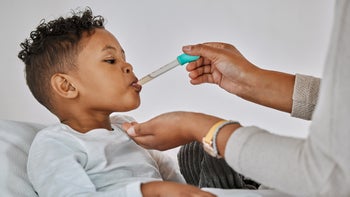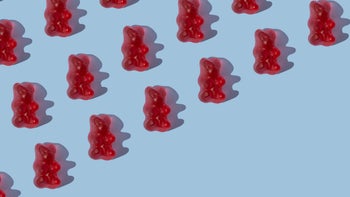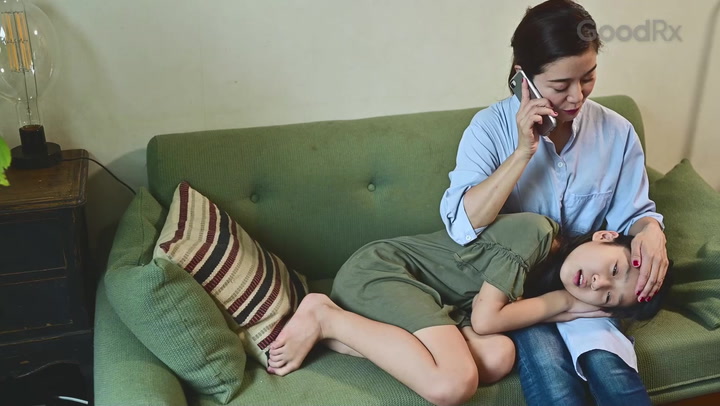
Which Over-the-Counter (OTC) Laxatives Are Safe for Kids?
Key takeaways:
Laxatives are medications that can help treat constipation in kids. They are used when lifestyle changes, like adding more water and fiber to the diet, are not enough.
There are several different types of over-the-counter laxatives that can be used for children. Polyethylene glycol 3350 (Miralax) is the first-choice treatment for constipation in children.
Laxatives are relatively safe to use in kids, but each one has its own side effects. Talk to your child’s medical provider to see which treatment option is best.

Constipation is common in children. But it can still be worrisome for parents. In fact, it’s the reason for up to 5% of office visits and 1 in 4 visits to a specialist. Fortunately, most cases are not due to any serious medical cause, and simple changes in the diet can help. But when adding more water and fiber to their diet isn’t enough, your child may need a laxative to help them poop.
Laxatives are medications that can help treat and prevent constipation. They work by either softening the stool or stimulating a bowel movement. With all the different types of laxatives out there, it can be hard to know which one to choose for your child. We’ll take a closer look at over-the-counter (OTC) laxatives that are safe to use in kids.
What does constipation look like in kids?
Constipation is when your child has hard, painful poops or is pooping less often than “normal.” What’s considered normal depends on the age of your child and differs from child to child. Some children can poop as often as three times a day or as few as three times a week.
Search and compare options
Breastfeeding infants tend to have softer and more frequent poop than infants who are fed formula (they tend to have firmer poop, and less often). It’s not unusual for breastfed babies to poop several times a day or after each feeding, especially in the first few weeks of life.
As your child gets older, they may start to poop less often. Around 4 years old, they may average about one poop per day and remain fairly constant after that.
Since bathroom habits differ among children and by age, it can be difficult to say when they're constipated. So pay attention to changes in what their poop looks like and how often they poop. Or encourage them to keep an eye out for these changes. This way you may be able to use simple natural remedies before it gets worse.
What are the best natural laxatives for kids?
If your child is constipated, you may want to try making lifestyle changes first before starting with a laxative. These changes include adding more water and fiber to their diet.
Water intake
If your child is not drinking enough water, it can make their stools harder and more difficult to pass. How much water your child needs will vary by age.
Here’s the suggested daily water intake for children by age:
6 to 12 months: 4 oz to 8 oz
1 to 3 years: about 4 cups
4 to 8 years: about 5 cups
8 years and older: about 8 cups
Read more like this
Explore these related articles, suggested for readers like you.
For infants, you can replace water with small amounts of juice. For infants over 3 months, you can try 1 oz of juice. For younger infants, you may be able to substitute ½ oz of water with juice. You can do this one to three times a day. Be sure to talk with your child’s provider before you make any dietary substitutions.
Fiber intake
Adding fiber to a child’s diet can also relieve constipation by helping to create larger and softer stools. Your child should eat at least five servings of fruits and vegetables per day to get the recommended daily amount of fiber.
Excellent sources of fiber have 5 grams or more in each serving. For example, this would be about ½ cup peas, 1 cup of carrots, or 1 large pear. Other good sources of fiber include:
Vegetables (like leafy greens, broccoli, beets, and asparagus)
Fruits or fruit purees (like apples, apricots, melons, and prunes)
Nuts
Whole-grain foods (like bread and cereal)
A quick way to estimate a child’s daily fiber needs is to add 5 to their age in years. Aim for them to have that number in grams of fiber per day.
Which laxatives are safe for kids?
There’s not enough data from large studies on the safety of laxatives in children. So laxatives are only FDA approved for adults. But many providers still recommend the use of OTC laxatives in kids because they’re well tolerated.
Let’s review the most common types of laxatives and their side effects in a bit more detail below.
1. Osmotic laxatives
Osmotic laxatives draw water into the stool to help it move through the colon quicker. Polyethylene glycol 3350 (Miralax) is the most commonly used osmotic laxative. It’s considered a first-choice laxative because it’s tasteless and children tolerate it well.
Miralax must be taken daily to be effective. It usually takes about 1 to 2 days to see results and can be used in children older than 6 months of age.
Lactulose is another type of osmotic laxative. Although it’s less effective than Miralax, it can be used as an alternative treatment if Miralax is unavailable. Lactulose is safe for all ages, and it can be used in infants younger than 6 months of age.
2. Bulking agents
Bulking agents are fiber supplements. They work by raising how much water is absorbed in the stool. This helps kids have larger and softer stools that are easier to pass. These products are safe to use daily, and it can take up to several days to provide relief. Examples of bulking agents include:
Psyllium (Metamucil)
Calcium polycarbophil (Fibercon)
Methylcellulose (Citrucel)
3. Stool softeners
Stool softeners raise the amount of water and fat in the stool. This softens the stool and makes it easier to pass. These laxatives can take 12 to 72 hours to have an effect. Stool softeners like docusate (Colace) are not meant for daily, long-term use.
4. Stimulant laxatives
Stimulants work to increase movement of the intestines, which helps your child poop. These medications are generally well tolerated. And they usually take effect within 6 to 8 hours. Stimulant laxatives include medications like senna (Senokot) and bisacodyl (Dulcolax).
5. Lubricants
Lubricants help poop slide out easier. You can give your child a lubricant by mouth or place it in the rectum. It may take about 1 to 2 days to see its effect. The most commonly used lubricant is mineral oil. And it is typically used in children over 3 years old.
6. Rectal therapies
Rectal therapies include suppositories and enemas. These treatments are placed in the rectum and tend to produce results within minutes. They work well to remove stool, but they’re not meant for regular or long-term use.
What are the side effects of laxatives in kids?
In general, laxatives are safe to use in kids. But there can be side effects. Common side effects of laxatives include:
Bloating
Cramping
Nausea
Gas
Abdominal pain
Worsening constipation when not taken with enough water (bulking agents)
Diarrhea (osmotic laxatives)
Rectal discomfort (enemas or suppositories)
There have been some concerns that osmotic laxatives, like Miralax, could be linked to behavioral changes in kids who use them. But the North American Society for Pediatric Gastroenterology, Hepatology and Nutrition reports that there’s no evidence to support these claims. Experts still recommend their use in children, although research is ongoing.
Are laxatives ever unsafe to use in kids?
While laxatives are generally safe to use, you should always check with a medical provider before giving your child a laxative. In some cases, laxatives should be used with extreme caution or avoided altogether.
It may not be safe to use a laxative if your child has a medical history of any of the following conditions:
Electrolyte imbalance (like sodium, potassium, or calcium)
Kidney problems
Seizure disorder
Bowel obstruction
Toxic megacolon
Bowel perforation
When should you get medical care for constipation in kids?
Constipation is quite common in children. And in many cases, it can be handled at home. But there are signs and symptoms that may signal a serious underlying condition.
Get medical help right away if your child has symptoms like:
Bloody stools
Poor growth
Swollen belly
Fever
Vomiting of bile (greenish, yellow digestive fluid)
No response to treatment
You should always get medical attention if an infant less than 1 month old is constipated.
The bottom line
Constipation is a common childhood problem. When dietary changes are not enough, your child may need a laxative for relief. Over-the-counter (OTC) laxatives are generally safe to use in kids. And there are many different types of laxatives to choose from. But there can be side effects. If your child has constipation, talk to their provider for guidance on the best laxative to use to relieve their symptoms.
Why trust our experts?


References
American College of Gastroenterology. (2012). Constipation in children.
GlaxoSmithKline Consumer Healthcare Holdings (US) LLC. (2022). Citrucel- methylcellulose powder, for solution [package insert]. DailyMed.
Healthychildren.org. (2013). Kids need fiber: Here’s why and how.
Koppen, I. J. N., et al. (2015). Management of functional constipation in children: Therapy in practice. Paediatric Drugs.
Levy, D., et al. (2005). Know thy laxatives: A parent’s guide to the successful management of chronic functional constipation in infants and children. International Foundation for Gastrointestinal Disorders.
North American Society for Pediatric Gastroenterology, Hepatology and Nutrition. (n.d.). FDA regulations.
Philichi, L. (2018). Management of childhood functional constipation. Journal of Pediatric Health Care.
Reeves, P. T., et al. (2022). Constipation in children. Healthychildren.org.
Rethy, J. (2020). Choose water for healthy hydration. Healthychildren.org.





























